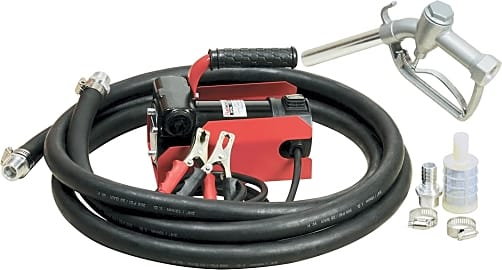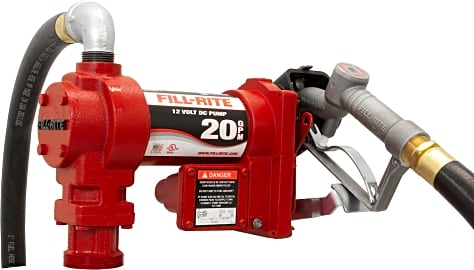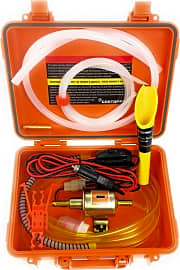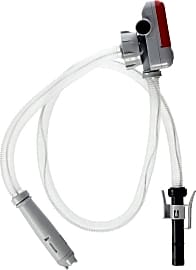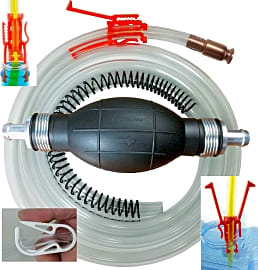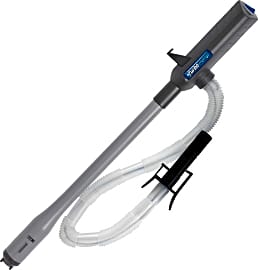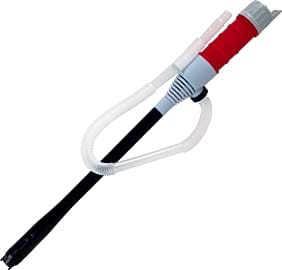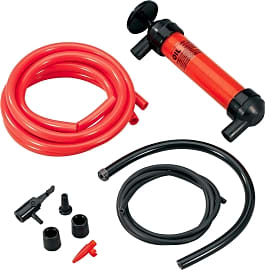The 10 Best Fuel Transfer Pumps

This wiki has been updated 39 times since it was first published in September of 2015. If you've ever tried to pour gasoline directly from a container into a vehicle or a generator, then you know how dangerous and messy it can be. That's where these fuel transfer pumps come in. One of the models on this list will let you keep anything topped up safely, from farm equipment to lawnmowers, motorcycles and your car, should you be unfortunate enough to run out of juice. When users buy our independently chosen editorial selections, we may earn commissions to help fund the Wiki.
Editor's Notes
November 15, 2020:
In this update we removed the Tera Pump due to a lack of consumer interest and replaced it with the Ontel TUPU-MC6, a portable, cordless, battery-powered option that features an auto-stop sensor so you can safely leave it alone without worrying about risk of spillover. It can fit the rims of most gas cans, too, thanks to the included hands-free clip.
We considered replacing the Fill-Rite 12V with its more popular counterpart that pumps fifteen gallons per minute, but the former has such good reviews, and pumps gas so much faster, that we decided not to make any changes.
Make sure to read our descriptions carefully so that you know whether or not the item you’re considering purchasing can be used to pump the fuel you need them to. For example, the Roughneck 8GPM and the Fuelworks Electric Diesel both pump diesel, but not gasoline, and you wouldn't want to purchase either of these only to find out that you couldn't ultimately use it.
September 05, 2019:
Transferring fuel from one storage container to another, or from storage to a tank on anything from a lawnmower to a motorcycle, requires the utmost safety. These are highly combustible materials that release plenty of unhealthy fumes and have the potential to wreak havoc on just about anything they touch. For that reason, safety and reliable performance are paramount when putting together a list of fuel transfer pumps. What makes a safe pump? Things like durable hoses, screens to catch any debris inside a barrel, ergonomic handles, and durable hoses are just the tip of the iceberg.
On this iteration, we said good-bye to the model from XtremePower US, as the fail rate of its rather noisy pump was a little too high, and as its components didn't seem capable of standing up to long-term use. We replaced it with a top-tier model from Fill-Rite, which landed in our number one spot on the strength of its pump rate, its comfort in the hand, and its exceptional durability. Our previous number one option, the Sierra Tools Battery-Op, proved to be a bit too light-duty to deserve its place at the top, even if it is a good performer for its class, and it's been rightfully demoted.
Why Use A Fuel Transfer Pump?
Liquid gasoline is actually a combination of over 150 hydrocarbons, paraffin, and alkenes, among other compounds.
Most obviously, using a fuel transfer pump aids in transferring fuel from one container to another. This has its own inherent benefits. Manual siphoning is impractical in many cases, and large containers cannot be easily lifted to funnel liquids into smaller containers. In these cases, a fuel pump is a definite need.
There is another important factor which many people overlook, however. Using a fuel pump also limits your exposure to gasoline vapors. This alone is reason enough to make the switch. Liquid gasoline is actually a combination of over 150 hydrocarbons, paraffin, and alkenes, among other compounds. The vapors of gasoline actually have a different makeup, though they come from the same product.
Gasoline vapor emits a great number of hydrocarbons into the atmosphere around it, making it a problem on both large and small scales. Globally, these hydrocarbons lead to higher greenhouse gas emissions which contribute to a depleting ozone layer. But on a localized scale, the effects are just as dangerous.
Regularly inhaling the volatile compounds which are heavily found in gas vapor leads to a higher risk of tumors, as many of these compounds are carcinogenic. Gasoline and its fumes are also associated with many other negative health risks in humans. Oxidative stress and haematotoxicity have been noted in subjects who were regularly exposed to petrol fumes.
In a study determining the long term effects of gasoline vapor inhalation on health, a team of researchers exposed subjects to daily doses of ambient gasoline vapor. At the end of 11 weeks, blood samples were run to determine the effect gasoline was having on the body. The team's findings indicated that gasoline reduced the amount of normal weight gain that occurred in test subjects. It was also associated with a reduction of healthy red blood cells and an increase in red blood cells which were malformed or under-functioning. The inhalation of gasoline was also associated with an increase in bone marrow abnormalities.
A fuel transfer pump can be easily employed in order to reduce contact with gasoline vapors and limit their release into the environment.
How to Use A Fuel Transfer Pump
Fuel transfer pumps are useful for everything from cars, planes, and tractors to snowmobiles, dirt-bikes, and even small motorized tools. Fuel transfer pumps work just as well with diesel fuel as they do with gasoline, and can be operated by hand pump, crank, or various motored options. Fuel transfer pumps can also provide a safe way to transfer various chemicals and hazardous materials without touching them.
Electricity is also a concern when using fuel transfer pumps.
To get the most out of a fuel transfer pump, it is important to understand how to best use it. Many fuel transfer pumps offer a simple design and relatively straightforward use. The three basic parts of a motored unit will be hosing, the motor, and the power supply. In manual units the motor and power supply are the same: usually a crank or lever for hand operation. While the exact operating instructions vary, the basics are to insert the inbound hose of the unit into the tank or can to be drained, and insert the outbound hose into the tank to be filled. After this step, simply supply power to the pump and turn it on; keeping an eye not to overfill the tank or can you are transferring to.
Just as important as proper operation of a fuel pump is adherence to safety precautions when using them. Combustible liquids can be lit by hot surfaces, static electricity, and electronic devices in some instances. To control the amount of flammable vapor in the air, be sure to only use pumps in well ventilated areas. Avoid using any fuel transfer pump in a closed garage.
Electricity is also a concern when using fuel transfer pumps. Even a very small spark is enough to cause a fire, which is evidenced by the 15 to 200 cases of static fires each year when fueling vehicles. While the pump is in operation, be sure not to unplug or plug anything into power sockets. Avoid turning lights on and off when the transfer is happening as well. Always maintain distance from any sources of electricity when using a fuel pump. Connect a motored fuel pump to a grounded outlet only. Very importantly, always wear protective eyewear, gloves, and hearing protection when using any sort of fuel pump.
Types Of Fuel Transfer Pumps
There are a few different types of fuel transfer pumps available for use. Depending upon your individual needs, one pump may be more suitable than another.
Centrifugal pumps are commonly seen on the marketplace. They offer a wide variety of uses, and are favored by many industrial companies as well. They can achieve high flow rates at a relatively low cost, and are often used to transfer to and from delivery vehicles and bulk tanks in the transportation sector.
There are a few different types of fuel transfer pumps available for use.
It is also common to see positive displacement pumps when searching for appropriate units. These pumps can achieve great suction, and can attain a high pressure output, up to several hundred PSI. Their flow capacities can greatly fluctuate as needed, from nearly a trickle to many gallons per hour. This high powered option does generally come with an increased cost of operation, however.
There are a couple different types of positive displacement pumps. Rotary vane pumps and hinged vane pumps differ in operating mechanics, but the results are the same: high powered hydraulic pumps which commonly make their way into heavy circulation. Power steering, transmission pumps, and even air injection pumps all use a type of vane pump.
Manual pumps are also available, and are perfect for emergency use. If the use of the unit will be limited to siphoning gas to a car that has lost its fuel or cleaning up a water leak in the home before it causes any damage, manual or battery operated pumps can achieve this easily. On the other hand, if the pump will see heavy use, it is better to steer clear of manual units and opt for high-powered motored units.



